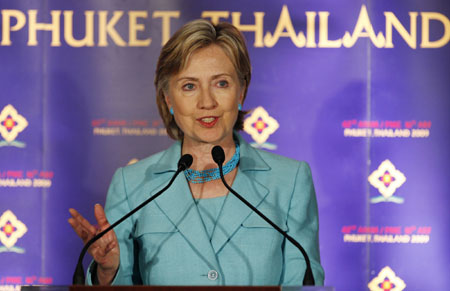By Zhou Erjie, Zhang Qiulai, Zhu Li
In a short sentence she delivered a clear message to the world -- "The United States is back in Southeast Asia," said US Secretary of State Hillary Clinton Wednesday, signaling deepening US engagement in the region after years' of negligence.
 |
|
US Secretary of State Hillary Clinton speaks during a news conference at the Association of Southeast Asian Nations (ASEAN) Regional Forum in Phuket July 22, 2009. [Xinhua]
|
The US signed the Treaty of Amity and Cooperation (TAC) in Southeast Asia with member states of the Association of Southeast Asia Nations (ASEAN) Wednesday in the southern Thai resort island of Phuket, a widely-watched move that could have profound implications for the future of Southeast Asia, as well as the Asia-Pacific region at large.
The TAC, a peace treaty, was signed in 1976. It is the ASEAN's founding non-aggression pact aimed at promoting regional stability. It was amended on Dec. 15, 1987 by a protocol to open the document for accession by states outside Southeast Asia.
The TAC establishes general principles governing the relations between State parties, with the intention of promoting "perpetual peace, everlasting amity and cooperation" within Southeast Asia.
Accession to the TAC by non-members often is seen as a symbol of commitment to engagement in Southeast Asia, and to the ASEAN's emphasis on multilateral processes.
"This treaty seals our commitment to work in partnership with the nations of ASEAN to advance the interest and values we share," Clinton said.
The US return to the region follows what many analysts say years of negligence, as US is preoccupied by Iraq and Afghanistan during the Bush Administration.
One oft-cited piece of evidence is that Condoleezza Rice, secretary of state under President George W. Bush, skipped the ASEAN Regional Forum -- Asia's largest forum on security and the one Clinton is to attend Thursday -- twice in three years, and did not show up at several major ASEAN conferences.
That's why in introducing Clinton during her visit to the ASEAN Secretariat in February 2009, ASEAN Secretary General Surin Pitsuwan said, "your visit shows the seriousness of the United States to end its diplomatic absenteeism in the region."
Now, under the Administration of Barack Obama, the United States seemed to have started a policy change on the region that is of key strategic importance and with immense linkage of interest.
"The US's love for the region was lost during the Bush administration. But it is not the case now that President (Barack) Obama is in power. Therefore, more active engagement with the region is anticipated," said Pavin Chachavalpongpun, a political scientist at Singapore's Institute of Southeast Asian Studies, according to media reports.
On Wednesday, Clinton said she and US President Barack Obama believed that Southeast Asia is vital to global progress, peace and prosperity. "Southeast Asia and ASEAN are critically important to our future," she said.
ASEAN's ten members host nearly 600 million people, including two of US treaty allies and the world's largest Muslim nation --Indonesia.
The region is the sixth largest export market of the US, a constant reminder of how important the region is to the US "To promote economic recovery and greater shared prosperity, we will continue working to expand trade and investment. Last year, two-way trade between ASEAN and the United States exceeded 178 billion US dollars, and there is no doubt that our economies' fortunes and our nations' futures are more intertwined than ever before," wrote Clinton in an opinion piece published on Tuesday's Bangkok Post.
US troops, too, are having military connections with some of the ASEAN's member nations. For years, its troops are equipping Indonesia's counter-terrorism forces and helping the Philippines to root out terrorist groups.
In his Asia Security Summit speech in May 2009, US Secretary of Defense Robert Gates made it clear that US accession to TAC would "demonstrates our willingness to take regional norms into account as we consider our relationships across the globe."
Additionally, many analysts see US accession to the TAC as a step to finally entering East Asia Summit (EAS), as it is one of the three requirements for joining the forum. The other two requirements are dialogue partnership and significant economic relations with ASEAN, both of which the United States already meets.
EAS, a forum that features an annual meeting among the heads-of-state of the ASEAN members, China, Japan, South Korea, India, Australia, and New Zealand, has played a increasing role in the Asia-Pacific region and the US may feel that it can't afford not being part of it.
At least Gates has partially admitted such an intention. Media reported that during questions after his May speech, Gates said the US would take a "step by step" approach to the issue of moving from the TAC to EAS membership.
(Xinhua News Agency July 23, 2009)